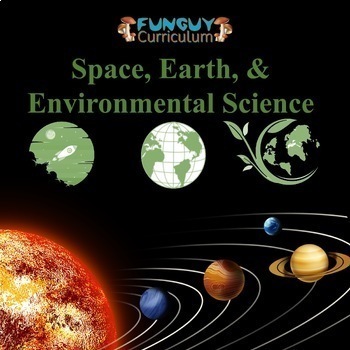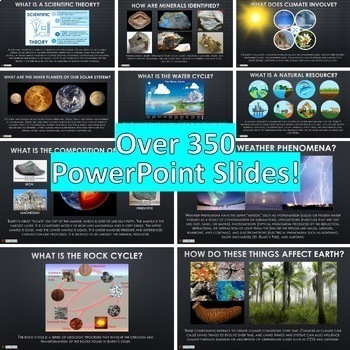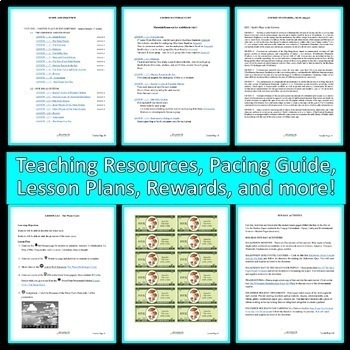Funguy Curriculum—Space, Earth, and Environmental Science
- Google Drive™ folder

Also included in
- Funguy Curriculum—Space, Earth, and Environmental Science (also known as just Environmental Science in some school districts) is a perfect resource for teachers who are new to this subject and even veteran teachers who want to simplify lesson planning. This full-year, complete science curriculum isPrice $249.98Original Price $259.98Save $10.00
Description
Funguy Curriculum—Space, Earth, and Environmental Science (also known as just Environmental Science in some school districts) is a perfect resource for teachers who are new to this subject and even veteran teachers who want to simplify lesson planning. This full-year, complete science curriculum is geared toward non-honors students who need an additional high school science credit. The Funguy Curriculum—Space, Earth, and Environmental Science—Teacher Pages includes the teaching resources you will need, including NGSS standards, list of materials needed, and lesson plans (each with a bell ringer, warm-up, PowerPoints slides, activity, and answer keys), reviews, study guides, and assessments, listed sequentially. Links to PowerPoint presentations on Google Drive are included in each lesson (requires a Gmail account). The student pages for printing and handing out are found listed sequentially in the document labeled Funguy Curriculum—Space, Earth, and Environmental Science—Student Pages.
Scope and Sequence
UNIT ONE—EARTH’S PLACE IN THE UNIVERSE
1.1—THE UNIVERSE AND ITS STARS
LESSON 1.1.0—Atom Review
LESSON 1.1.1—Big Bang Theory
LESSON 1.1.2—The Universe
LESSON 1.1.3—Galaxies
LESSON 1.1.4—The Milky Way
LESSON 1.1.5—Stars and Constellations
LESSON 1.1.6—The Star of our Solar System
LESSON 1.1.7—Nuclear Fusion in the Sun
LESSON 1.1.8—The Solar Cycle and Solar Activity
LESSON 1.1.9—Review
LESSON 1.1.10—Assessment
LESSON 1.1.11—Post Exam Fun Day
1.2—OUR SOLAR SYSTEM
LESSON 1.2.1—Kepler’s Laws of Planetary Motion
LESSON 1.2.2—Newton’s Law of Universal Gravity
LESSON 1.2.3—Our Solar System
LESSON 1.2.4—Inner Planets of Our Solar System
LESSON 1.2.5—Outer Planets of Our Solar System
LESSON 1.2.6—Review
LESSON 1.2.7—Assessment
LESSON 1.2.8—Post Exam Fun Day
1.3—THE HISTORY OF PLANET EARTH
LESSON 1.3.1—Formation of Earth
LESSON 1.3.2—Early Earth
LESSON 1.3.3—History of Life on Earth
LESSON 1.3.4—Radiometric Dating of Fossils
LESSON 1.3.5—Review
LESSON 1.3.6—Assessment
LESSON 1.3.7—Post Exam Fun Day
UNIT TWO—EARTH’S SYSTEMS
2.1—EARTH'S MATERIALS
LESSON 2.1.1—Earth's Layers
LESSON 2.1.2—The Rock cycle
LESSON 2.1.3—Minerals
LESSON 2.1.4—Identifying Minerals
LESSON 2.1.5—Identifying Rocks
LESSON 2.1.6—Review
LESSON 2.1.7—Assessment
LESSON 2.1.8—Post Exam Fun Day
2.2—PLATE TECTONICS
LESSON 2.2.1—Convection in the Mantle
LESSON 2.2.2—Plate tectonics
LESSON 2.2.3—Tectonic Plate Boundaries
LESSON 2.2.4—Convergent Boundaries
LESSON 2.2.5—Divergent Boundaries
LESSON 2.2.6—Transform Plate Boundaries
LESSON 2.2.7—Review
LESSON 2.2.8—Assessment
LESSON 2.2.9—Post Exam Fun Day
2.3—BIOGEOCHEMICAL CYCLES
LESSON 2.3.1—The Water Cycle
LESSON 2.3.2—The Oceanic Conveyer Belt
LESSON 2.3.3—Carbon Cycle
LESSON 2.3.4—Nitrogen Cycle
LESSON 2.3.5—The Sulfur and Phosphorus Cycles
LESSON 2.3.6—Biogeochemical Cycle Interaction
LESSON 2.3.7—Review
LESSON 2.3.8—Assessment
LESSON 2.3.9—Post Exam Fun Day
2.4—WEATHER AND CLIMATE
LESSON 2.4.1—Weather Overview
LESSON 2.4.2—Components of Weather
LESSON 2.4.3—Clouds
LESSON 2.4.4—Thunderstorms and Cyclones
LESSON 2.4.5—Thunderstorm Formation
LESSON 2.4.6—Weather Forecasting
LESSON 2.4.7—Climate Overview
LESSON 2.4.8—Components of Climate
LESSON 2.4.9—Review
LESSON 2.4.10—Assessment
LESSON 2.4.11—Post Exam Fun Day
UNIT THREE— EARTH AND HUMAN ACTIVITY
3.1— NATURAL RESOURCES AND HAZARDS
LESSON 3.1.1—Natural resources
LESSON 3.1.2—Earthquakes
LESSON 3.1.3—Volcanoes
LESSON 3.1.4—Tsunamis
LESSON 3.1.5—Tornadoes
LESSON 3.1.6—Hurricanes
LESSON 3.1.7—Other Natural Disasters
LESSON 3.1.8—Review
LESSON 3.1.9—Assessment
LESSON 3.1.10—Post Exam Fun Day
3.2—HUMAN IMPACTS ON EARTH SPHERES
LESSON 3.2.1— Impacts on the Geosphere
LESSON 3.2.2— Impacts on the Atmosphere
LESSON 3.2.3— Impacts on the Hydrosphere
LESSON 3.2.4— Impacts on the Biosphere
LESSON 3.2.5—Review
LESSON 3.2.6—Assessment
LESSON 3.2.7—Post Exam Fun Day
3.3 GLOBAL CLIMATE CHANGE
LESSON 3.3.1—Climate Change Overview
LESSON 3.3.2—Natural Causes of Climate Change
LESSON 3.3.3—Anthropogenic Causes of Climate Change
LESSON 3.3.4—Potential Impacts of Climate Change
LESSON 3.3.5—Review
LESSON 3.3.6—Assessment
LESSON 3.3.7—Post Exam Fun Day






